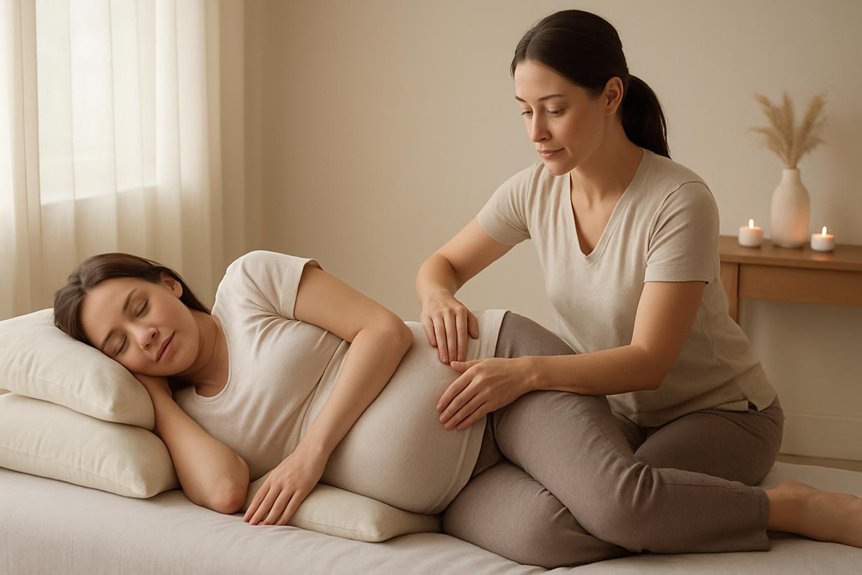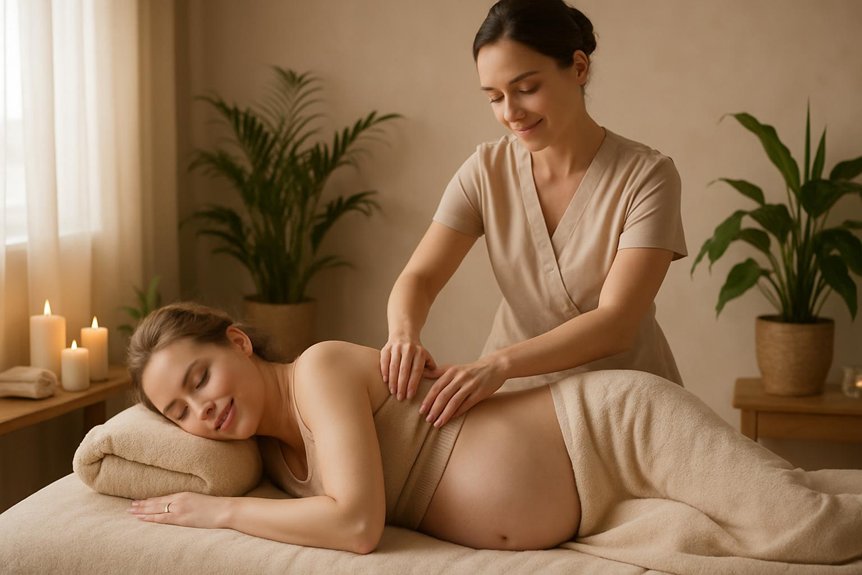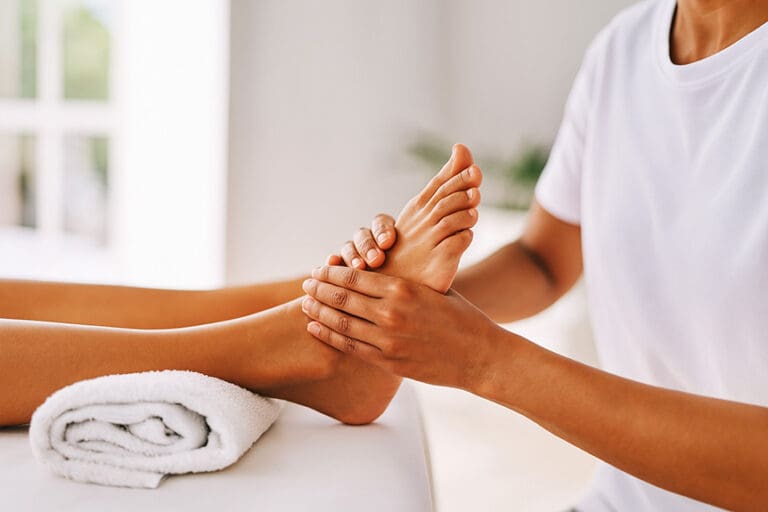A gentle back massage is generally safe in early pregnancy when performed by a trained prenatal therapist who screens for risks and adapts positioning and pressure. Side-lying with pillows is preferred; brief semi-recline is acceptable. Use light-to-moderate pressure, avoid abdominal work, and pause if pain, dizziness, or bleeding occurs. Massage should be deferred with high-risk conditions (e.g., preeclampsia, placenta previa, clotting disorders). Unscented oils help reduce nausea. Clients benefit from calmer sleep, less tension, and tailored care. Learn what to expect next.
Is a Back Massage Safe in the First Trimester?

In early pregnancy, a back massage can be safe when delivered by a trained prenatal therapist using appropriate positioning and pressure, with adjustments based on the individual’s health history and symptoms.
Current evidence and clinical guidelines support gentle, non-abdominal work in the first trimester when contraindications are screened.
At Spa & Massage, therapists conduct a thorough intake (including bleeding, pain, prior miscarriage, clotting disorders, IVF, and high-risk flags) and coordinate side-lying or semi-reclined positioning to avoid aortocaval compression and nausea.
Pressure remains light to moderate, avoiding deep work over the low back and sacrum.
Neutral, fragrance-free or mild hypoallergenic oils are preferred; aromatics are used cautiously.
Clients are encouraged to communicate continuously, pause for dizziness or nausea, and seek obstetric guidance if concerns arise.
Incorporating aromatherapy massage techniques can further enhance relaxation and support well-being during pregnancy, provided the therapist carefully selects safe, pregnancy-appropriate essential oils.
Benefits of Gentle Massage During Early Pregnancy
Having established first-trimester safety parameters, attention turns to what gentle back massage can offer during early pregnancy. Evidence suggests light, well-positioned touch can reduce perceived pain, soften muscular guarding in the lumbar and thoracic regions, and calm sympathetic arousal—supporting steadier sleep and less nausea-related tension.
Clients often report easier breathing, fewer tension headaches, and improved mood through measured reductions in cortisol and enhanced parasympathetic tone. At Spa & Massage clinics in London, therapists use pregnancy-appropriate positioning to ease sacroiliac strain and postural fatigue from early hormonal changes.
Gentle strokes encourage local circulation and lymphatic flow, helping mitigate fluid retention and breast- or rib-related tightness that can tug on the back. Sessions are paced to the client’s energy, with continuous consent, grounding touch, and clear communication to maintain comfort and emotional safety.
Techniques Our Therapists Use for First-Trimester Care
Spa & Massage therapists prioritise gentle side‑lying positioning with supportive bolsters to protect circulation and reduce lumbar strain in the first trimester.
Sessions use light, graded pressure with slower pacing to respect tissue sensitivity and mitigate nausea or fatigue, consistent with current pregnancy‑massage safety guidance.
Techniques are adapted continuously to client feedback, ensuring comfort while targeting common back tension safely.
Gentle Side-Lying Positioning
Although many first‑trimester clients can lie prone comfortably, side‑lying positioning is often selected to minimise abdominal pressure and support circulation.
In Spa & Massage clinics, therapists use a supported lateral posture with a neutral spine: a firm pillow or wedge cradles the head and neck, a soft bolster rests between knees to align hips, and a folded towel cushions the abdomen without compression.
This configuration helps maintain venous return, reduces lumbar tension, and allows clear access to paraspinals and lateral back muscles.
Communication remains central. Therapists check breath ease, shoulder comfort, and pelvic stability, and adjust angles subtly to avoid strain.
Friction and stretch are moderated by the body’s natural drape, enabling gentle, attentive work while maintaining modesty, warmth, and an unhurried, reassuring cadence.
Light Pressure and Pacing
While maternal physiology adapts rapidly in the first trimester, tissue sensitivity and fatigue can increase, so therapists at Spa & Massage employ light, measured pressure and slower pacing to prioritise safety and comfort.
They begin with gentle effleurage to assess reactivity, then use short, controlled strokes over paraspinals and shoulders, maintaining pressure within a client-defined “2–3 out of 10” range. Rhythm is unhurried to support autonomic downregulation and reduce nausea risk.
Tender points are approached with brief holds rather than friction.
Therapists avoid sustained compression over the lumbosacral area and modify depth around the rib cage and iliac crest.
Communication is continuous: clients are invited to guide adjustments breath by breath.
Sessions conclude with gradual de-escalation, hydration advice, and rest recommendations to prolong relief.
Positions and Pillowing for Comfort and Safety

Because maternal comfort and uteroplacental safety guide every decision in early pregnancy massage, ideal positioning and strategic pillowing are essential.
In early gestation, side-lying with a slight forward tilt is generally preferred; it reduces aortocaval compression and supports relaxed breathing.
A small wedge or folded towel under the abdomen, a cushion between the knees, and a pillow to cradle the upper arm maintain neutral spinal alignment and ease lumbar tension.
Short, supported prone positioning may be used if breast and abdominal tenderness permit, using a soft chest recess and low abdominal pressure.
Semi-reclined supine positioning is brief and angled (at least 30 degrees) to protect circulation.
At Spa & Massage, therapists adjust bolsters moment-to-moment, invite feedback, and prioritise unforced, cosy containment that feels secure, breathable, and intimate without strain.
When to Avoid Massage and Seek Medical Advice
Comfort-focused positioning is only one part of safe care; knowing when massage should be paused and a clinician consulted is equally important.
Massage should be avoided and medical advice sought if there is vaginal bleeding, fluid leakage, fever, severe abdominal or back pain, dizziness or fainting, chest pain, shortness of breath, calf pain or swelling (possible DVT), severe headache, visual changes, reduced fetal movement later in pregnancy, or a new rash or infection.
Those with placenta previa, preeclampsia, uncontrolled hypertension, poorly controlled diabetes, recent trauma, or a history of blood clots should obtain obstetric clearance.
At Spa & Massage, therapists screen for red flags and adapt or defer sessions accordingly, prioritising safety and tenderness.
Clients are encouraged to share new symptoms promptly and follow clinician guidance.
How to Prepare for a Pregnancy-Safe Back Massage at Spa & Massage
Before booking, the client is encouraged to share pregnancy details, relevant medical history, and any current symptoms so therapists can tailor care safely.
Appointments are best timed when nausea is minimal, with side-lying or semi-reclined positioning used at Spa & Massage to protect uteroplacental blood flow and spinal comfort.
Comfort measures—such as additional pillows, lighter pressure, fragrance-free oils if sensitive, and easy breaks—are standard in our clinics to maintain safety and relaxation.
Share Health Details
What information should be shared to guarantee a pregnancy-safe back massage? Clients should disclose gestational age, any prior pregnancy losses, fertility treatments, bleeding, cramping, or fluid loss, and whether a clinician has advised activity restrictions. They should report placenta concerns, hypertension or preeclampsia, diabetes, clotting disorders, thrombosis history, sciatica, herniated discs, and recent infections or fever.
Medication use, allergies (including to nuts or essential oils), skin sensitivities, and nausea or headache patterns matter. They should note faintness, shortness of breath, or dizziness.
At Spa & Massage, therapists use this information to tailor pressure, avoid contraindicated areas, and select neutral, pregnancy-safe oils; unscented options are available. Clients are invited to articulate touch preferences, privacy needs, and boundaries.
Transparent sharing supports comfort, emotional ease, and clinically sound care.
Timing, Positioning, Comfort
Although individual needs vary, early pregnancy back massage is best scheduled when nausea and fatigue are least pronounced, typically mid-morning or early afternoon, and no sooner than after a clinician has confirmed an uncomplicated pregnancy.
At Spa & Massage, therapists recommend a light meal and hydration beforehand, avoiding caffeine.
For positioning, side-lying with supportive pillows is preferred; prone positioning is avoided, and supine time is limited to brief intervals to reduce vena cava compression.
Pressure remains gentle-to-moderate, with lower-back and gluteal work adapted to comfort and safety.
Therapists at our London clinics use neutral, unscented or mild citrus oils unless a client prefers fragrance-free options.
Clients are encouraged to signal warmth, room lighting, and pressure needs in real time.
Aftercare includes slow rising, water, and brief walking to reduce dizziness.
Conclusion
In early pregnancy, the body is a garden newly sown—tender shoots needing careful tending. Evidence suggests gentle, specialist-led back massage can nurture this growth: easing tension, supporting rest, and honoring evolving anatomy. Therapists at Spa & Massage act as skilled gardeners, adapting tools—positions, pressure, and neutral oils—while avoiding fragile borders. When warning signs appear, the gate stays closed and medical counsel is sought. With informed consent, clear communication, and prudent aftercare, clients can cultivate comfort safely through the first trimester.



